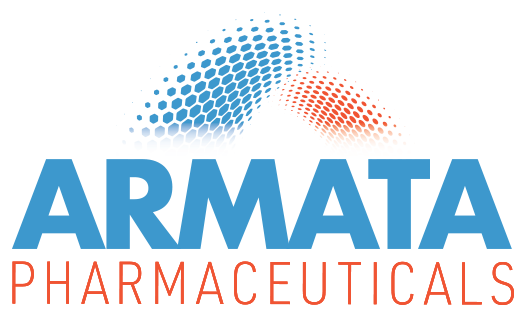AP-PA02
AP-PA02 is a therapeutic phage cocktail that targets the pathogen P. aeruginosa, to treat serious respiratory infections, with an emphasis on patients with cystic fibrosis (CF) and non-cystic fibrosis bronchiectasis (NCFB).
AP-PA02 is one example of the novel product candidates to emerge from Armata’s robust research and development capabilities. Phages that comprise AP-PA02 were selected with desired attributes for a product candidate targeting P. aeruginosa lung infections. AP-PA02 is comprised of a cocktail of natural P. aeruginosa phages originating from distinct families and subfamilies, targeting multiple receptor classes, functioning with compatibility and cooperativity, and further characterized by being highly potent and having a broad host range. Preclinical highlights of AP-PA02 include:
- Significantly reduced P. aeruginosa biofilm mass in vitro;
- Persistence of active phage particles in the lung;
- Limited systemic and off-target organ distribution;
- Decreased mortality in a murine model of acute P. aeruginosa lung infection;
- Components are stable in relevant biological fluids, such as sputum;
- Not antagonistic with standard of care antibiotics; and
- Active in the presence of other CF therapies.
AP-PA02 is developed as a sterile liquid formulation, suitable for delivery by inhalation. Clinical trial material of AP-PA02 is manufactured under cGMP at Armata’s production facility in California.
Clinical Development of AP-PA02
Cystic Fibrosis: Completed Phase 1b/2a “SWARM-P.a.” Study
In October 2020, Armata received FDA clearance for its IND to initiate the “SWARM-P.a.” study – a Phase 1b/2a, multicenter, double-blind, randomized, placebo-controlled, single ascending dose (SAD) and multiple ascending dose (MAD) clinical trial to evaluate the safety and tolerability of inhaled AP-PA02 administered by inhalation in subjects with cystic fibrosis and chronic pulmonary Pseudomonas aeruginosa infection.
The SWARM-P.a. study was supported by a $5 million Therapeutics Development Award from the Cystic Fibrosis Foundation.
In the first quarter of 2023, Armata announced positive topline results from the completed “SWARM-P.a.” study. Data indicate that AP-PA02 was well-tolerated with a treatment emergent adverse event profile similar to placebo. Pharmacokinetics findings confirm that AP-PA02 can be effectively delivered to the lungs through nebulization with minimal systemic exposure, with single ascending doses and multiple ascending doses resulting in a proportional increase in exposure as measured in induced sputum. AP-PA02 exposures were generally consistent across subjects. Additionally, bacterial levels of P. aeruginosa in the sputum measured at several timepoints suggest improvement in bacterial load reduction for subjects treated with AP-PA02 at the end of treatment as compared to placebo after ten days of dosing. In addition, a correlation was seen between increasing phage dose (higher AP-PA02 exposures) and reduction in the bacterial load, supporting the biologic plausibility of a bacterial specific mechanism of action and creating the opportunity for phage as a therapeutic alternative to inhaled antibiotics.
Following the promising Phase 1b/2a results of favorable safety and tolerability profile and plausible mechanism of action, an additional confirmatory Phase 2 trial was initiated in non-cystic fibrosis Bronchiectasis (NCFB) patients with similar chronic pulmonary disease with infections due to P. aeruginosa.
Non-Cystic Fibrosis Bronchiectasis: Completed Phase 2 “Tailwind” Study
On February 22, 2022, Armata announced that it had received approval from the FDA to proceed with the IND application for inhaled AP-PA02, in a second indication, NCFB.
In December 2024, we announced encouraging topline results from the completed Tailwind study – a Phase 2, multicenter, double-blind, randomized, placebo-controlled study to evaluate the safety, phage kinetics, and efficacy of inhaled AP-PA02 phage therapeutic in subjects with NCFB and chronic pulmonary P. aeruginosa infection. Data indicated that inhaled AP-PA02 provides a durable reduction of P. aeruginosa in the lung, with a favorable safety and tolerability profile. The Tailwind study was conducted in two cohorts running in parallel: subjects in one cohort (cohort A) received inhaled AP-PA02 as monotherapy, while subjects in another cohort (cohort B) received inhaled AP-PA02 in combination with inhaled anti-pseudomonal antibiotic treatment. Subjects in both cohorts were dosed at home by nebulization with study drug administered every 12 hours for 10 days and were followed for approximately four weeks after receiving their last dose of study drug. The primary efficacy endpoint was the reduction in P. aeruginosa colony forming units (“CFUs”) in lung sputum at one week following completion of dosing (day 17) compared to baseline. Per the statistical analysis plan, efficacy analysis of each independent cohort showed no significant difference between subjects treated with AP-PA02 and placebo due to small numbers of subjects in each cohort. Notably, a post-hoc intent-to-treat analysis (n=33 active and n=15 placebo; all subjects from both cohorts) demonstrated a statistically significant reduction of P. aeruginosa CFUs in the lung at day 17 (AP-PA02 vs. placebo; P=0.05). The reduction in P. aeruginosa CFUs persisted two weeks following completion of dosing with AP-PA02 when compared with placebo at day 24 (AP-PA02 vs. placebo; P=0.015). Additionally, paired analysis of P. aeruginosa CFU density at baseline compared to day 10 (P=0.03), day 11 (P=0.01), day 17 (P=0.003) and day 24 (P=0.018) was significant in the AP-PA02-treated cohort. We believe the data suggest that AP-PA02 alone is as effective as the combination therapy of phage and antibiotics in reducing P. aeruginosa CFUs in the lung. Additionally, approximately one-third of subjects treated with phage monotherapy exhibited at least a 2-log CFU reduction in P. aeruginosa compared to no reduction in placebo treated subjects. Safety data indicate that inhaled AP-PA02 was well-tolerated with treatment-emergent adverse events mild and self-limiting. There was one possibly related serious adverse event that was linked to an acute pulmonary event requiring hospitalization that was responsive to antibiotics. We believe the safety and tolerability of AP-PA02 offers a promising profile for treating chronically infected NCFB patients.
Results from the Phase 2 Tailwind study demonstrate the potential of Armata’s high-purity phage cocktail, AP-PA02, as a new monotherapy treatment alternative for chronic pulmonary disease caused by P. aeruginosa infection, including drug-resistant bacteria, and indicate the potential for phage therapy to reduce reliance on chronic antibiotic use. The Phase 2 Tailwind study represents the second successful clinical trial for AP-PA02, Armata’s lead pulmonary candidate, which was first evaluated in people with cystic fibrosis in the Phase 1b/2a SWARM-P.a. trial that completed in 2023. We believe the learnings on dose-schedule regimens gained from the two completed Phase 2 studies position us to define a safe and promising biologic correlation for a Phase 3 definitive trial which will aim to evaluate inhaled AP-PA02 as an alternative to antibiotics in chronic pulmonary P. aeruginosa infection.
Target Market and Medical Need
P. aeruginosa is consistently recognized by the CDC, and other public health agencies, as among the most dangerousand difficult-to-treat pathogens associated with significant impacts on health, quality of life, and economic burden.
P. aeruginosa is particularly problematic for CF patients given that their already compromised immune system leads to chronic infections. CF affects over 40,000 people in the U.S. (105,000 people worldwide) with approximately 1,000 new diagnoses per year. Outcomes for people with CF have improved significantly in recent years through early screening, the development and use of CFTR modulators, and other therapies. However, people with CF still suffer significant morbidity and mortality due to pulmonary infection with P. aeruginosa. Chronic P. aeruginosa infections occur in 45% of CF patients by age 40, and are strongly associated with worsening lung function, frequent pulmonary exacerbations, and increased mortality. Regular standard-of-care antibiotics treatments often fail to completely eradicate the pathogen, and the problem is further complicated by rising rates of antibiotic resistance due to a growing number of multidrug-resistant isolates emerging, particularly with long term use. Hence the need for more effective therapies, ideally with a different mechanism of action compared to traditional antibiotics, for the treatment of chronic P. aeruginosa infection. GlobalData projects that total antibiotic sales in the CF market will exceed $900 million in the U.S. in 2030.
NCFB is a chronic respiratory disease affecting more than 100,000 people in the U.S. and 200,000 people in Europe, characterized by recurrent respiratory infections that lead to a vicious cycle of impaired mucociliary clearance, chronic infection, bronchial inflammation, and progressive lung function loss. P. aeruginosa is the most prevalent pathogen responsible for these recurrent infections. It is found in approximately 30% of cases and is associated with enhanced disease progression, including poorer lung function and lower quality of life, more frequent exacerbations, increased hospitalizations, and higher mortality. NCFB patients frequently become chronically colonized with multidrug-resistant strains of P. aeruginosa because of the need for repeated courses of antibiotic treatment. There are currently no FDA approved inhaled antibiotics for the treatment of NCFB patients with chronic P. aeruginosa respiratory infection.
AP-PA03
Representing the different physiology of acute pneumonia lung infections as compared to chronic CF and NCFB respiratory infections, a novel cocktail is in development for the clinical indication of acute hospitalized pneumonia. Armata has deployed its extensive P. aeruginosa clinical isolate collection and phage library to identify a candidate phage cocktail, AP-PA03. Hospital-acquired pneumonia and ventilated-associated pneumonia is one of the most common causes of death among all hospital‐acquired infections, with approximately 300,000 hospitalizations each year in the U.S. due to Pseudomonas. Infection with Pseudomonas results in mortality rates ranging as high as 35‐50%, drives considerable healthcare costs, and accounts for around 50% of all intensive care unit antibiotics.

